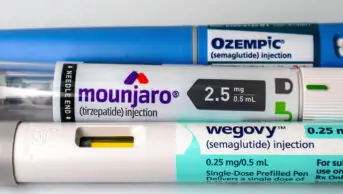
Shutterstock.com
Patients with diabetes using glucagon-like peptide-1 receptor agonists (GLP-1 RAs) were twice as likely to develop neovascular age-related macular degeneration (nAMD), although the overall risk remains low, according to results from a cohort study.
The study, published in JAMA Ophthalmology on 5 June 2025, reported a “low but substantially higher risk of being diagnosed with nAMD” among patients exposed to GLP-1 RAs, compared with those who were not.
Researchers analysed data from a cohort of 46,334 patients with diabetes who had been exposed to GLP-1 RAs for six months or more, and 92,668 unexposed matched patients with diabetes.
Of those participants with GLP 1-RA exposure, 0.2% of patients received a new nAMD diagnosis during the nearly three-year period between identifying and following up patients, compared with 0.1% of patients not exposed to the drug, the study found.
According to the study, this finding remained the same even when adjusted for sociodemographic characteristics and medical comorbidities.
Of the total cohort of participants, 47% of patients were women and the mean patient age was 66.2 years, the study results show.
The findings of the study also demonstrated that the majority of patients (97.5%) exposed to GLP-1 RAs used semaglutide, while the remaining 2.5% of patients used lixisenatide.
The association between GLP-1 RA use and increased nAMD risk was the opposite of what they had anticipated, the researchers said.
The paper noted: “Insulin resistance at the level of the retina is also postulated to play an important role in the pathophysiology of nAMD, which may be more pronounced in the neovascular form of the disorder.
“Given that GLP-1 RAs can effectively and consistently reduce insulin resistance in patients with diabetes, these agents were anticipated to reduce the risk of nAMD in patients with diabetes through this mechanism.
“However, our analysis revealed the opposite: patients with diabetes who were exposed to GLP-1 RAs had a substantially higher risk of being diagnosed with nAMD, with a shorter time to diagnosis, compared with propensity-matched patients who were unexposed.”
The researchers also revealed that this finding comes amid “numerous reports” in other literature of “unexpected worsening of diabetic retinopathy following a rapid reduction in blood glucose levels”.
“At the same time, findings from clinical trials contradict those from experimental studies, the latter of which demonstrate that GLP-1 RAs may prevent the onset of diabetic retinopathy or dampen its progression via anti-inflammatory and anti-apoptotic pathways,” the paper said.
Longer durations of exposure to GLP-1 RAs were associated with a higher risk of nAMD, with more than three times the risk among those with the longest exposure to GLP-1 RAs, the study found.
The researchers suggested the increased risk may be linked to the impact of GLP-1 RAs on retinal GLP-1 receptors, although the underlying mechanisms remain “poorly understood” and warrant further study.
With the growing use of GLP-1 RAs across various conditions, clinicians should be aware of potential ocular complications and report any suspected adverse effects.
Commenting on the study, Philip Newland-Jones, consultant pharmacist in diabetes and endocrinology at University Hospital Southampton NHS Foundation Trust, said: “I think it is an interesting correlation, but certainly doesn’t show causation at this stage with this evidence.
“I can’t see that [the researchers] have matched for BMI, which I would imagine is also a risk factor in progression. There may be a difference in BMI between groups that were offered GLP-1 RAs and those that were not.”
“Given the very low incidence of [nAMD] occurring, it would be interesting to review this as part of other studies and possibly in future placebo controlled studies, rather than retrospective database analysis as there are many caveats to this sort of data,” he added.
Peter Bloomfield, director of research at the Macular Society, said: “This is a useful area of research. Much more needs to be understood about this class of medication and any long-term health implications, particularly where use spans health and disease.”
On 5 June 2025, the Medicines and Healthcare products Regulatory Agency urged women taking GLP-1 RAs to use effective contraception, with those taking Mounjaro (tirzepatide; Eli Lilly) requiring a non-oral contraceptive.

